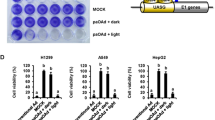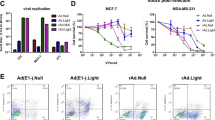Abstract
There are at least two hurdles confronting the use of the adenovirus (Ad)-mediated herpes simplex virus thymidine kinase (HSVtk)/ganciclovir (GCV) system for the treatment of cancer. One is inefficient Ad vector–mediated gene transfer into tumor cells lacking the primary receptor, i.e., the coxsackievirus and adenovirus receptor (CAR). The other is hepatotoxicity due to unwanted vector spread into the liver, even when Ad vectors are injected intratumorally. Herein, we present an attractive strategy for overcoming such limitations based on use of a fiber-modified Ad vector containing an RGD peptide motif in the fiber knob. HSVtk-expressing Ad vectors containing mutant fiber (AdRGD-tk) or wild-type fiber (Ad-tk) were injected intratumorally into CAR-negative B16 melanoma cells inoculated into mice, after which GCV was injected intraperitoneally for 10 days. AdRGD-tk showed approximately 25 times more antitumor activity than Ad-tk. Histopathological studies suggested that liver damage in mice injected with AdRGD-tk was significantly lower than that in mice injected with Ad-tk. Intratumoral administration of luciferase-expressing Ad vectors containing the mutant fiber (AdRGD-L2) resulted in nearly 40 times more luciferase production in the tumor, but 8 times less production in the liver than the conventional Ad vectors (Ad-L2). These results indicate that combination of fiber-modified vectors and a HSVtk/GCV system is a potentially useful and safe approach for the treatment of tumors lacking CAR expression, and that fiber-modified vectors could be of great utility for gene therapy and gene transfer experiments.
This is a preview of subscription content, access via your institution
Access options
Subscribe to this journal
Receive 12 print issues and online access
$259.00 per year
only $21.58 per issue
Buy this article
- Purchase on Springer Link
- Instant access to full article PDF
Prices may be subject to local taxes which are calculated during checkout




Similar content being viewed by others
References
Chen SH, Shine HD, Goodman JC, Grossman RG, Woo SL . Gene therapy for brain tumors: regression of experimental gliomas by adenovirus-mediated gene transfer in vivo Proc Natl Acad Sci USA 1994 91: 3054–3057
Culver KW, Ram Z, Wallbridge S et al. In vivo gene transfer with retroviral vector–producer cells for treatment of experimental brain tumors Science 1992 256: 1550–1552
Kucharczuk JC, Raper S, Elshami AA et al. Safety of intrapleurally administered recombinant adenovirus carrying herpes simplex thymidine kinase DNA followed by ganciclovir therapy in nonhuman primates Hum Gene Ther 1996 7: 2225–2233
Oldfield EH, Ram Z, Culver KW et al. Gene therapy for the treatment of brain tumors using intra-tumoral transduction with the thymidine kinase gene and intravenous ganciclovir Hum Gene Ther 1993 4: 39–69
Ram Z, Culver KW, Oshiro EM et al. Therapy of malignant brain tumors by intratumoral implantation of retroviral vector-producing cells Nat Med 1997 3: 1354–1361
Vincent AJ, Vogels R, Someren GV et al. Herpes simplex virus thymidine kinase gene therapy for rat malignant brain tumors Hum Gene Ther 1996 7: 197–205
Izquierdo M, Martin V, de Felipe P et al. Human malignant brain tumor response to herpes simplex thymidine kinase (HSVtk)/ganciclovir gene therapy Gene Ther 1996 3: 491–495
Klatzmann D, Valery CA, Bensimon G et al. A phase I/II study of herpes simplex virus type 1 thymidine kinase “suicide” gene therapy for recurrent glioblastoma. Study group on gene therapy for glioblastoma Hum Gene Ther 1998 9: 2595–2604
Shand N, Weber F, Mariani L et al. A phase 1–2 clinical trial of gene therapy for recurrent glioblastoma multiforme by tumor transduction with the herpes simplex thymidine kinase gene followed by ganciclovir. GLI328 European–Canadian study group Hum Gene Ther 1999 10: 2325–2335
Sterman DH, Treat J, Litzky LA et al. Adenovirus-mediated herpes simplex virus thymidine kinase/ganciclovir gene therapy in patients with localized malignancy: results of a phase I clinical trial in malignant mesothelioma Hum Gene Ther 1998 9: 1083–1092
Vincent AJ, Esandi MC, Avezaat CJ et al. Preclinical testing of recombinant adenoviral herpes simplex virus-thymidine kinase gene therapy for central nervous system malignancies Neurosurgery 1997 41: 442–451
Freeman SM, Abboud CN, Whartenby KA et al. The “bystander effect:” tumor regression when a fraction of the tumor mass is genetically modified Cancer Res 1993 53: 5274–5283
Mesnil M, Piccoli C, Tiraby G, Willecke K, Yamasaki H . Bystander killing of cancer cells by herpes simplex virus thymidine kinase gene is mediated by connexins Proc Natl Acad Sci USA 1996 93: 1831–1835
Mesnil M, Yamasaki H . Bystander effect in herpes simplex virus-thymidine kinase/ganciclovir cancer gene therapy: role of gap-junctional intercellular communication Cancer Res 2000 60: 3989–3999
Kovesdi I, Brough D, Bruder J, Wickham T . Adenoviral vectors for gene transfer Curr Opin Biotechnol 1997 8: 583–589
Yeh P, Perricaudet M . Advances in adenoviral vectors: from genetic engineering to their biology FASEB J 1997 11: 615–623
Bergelson JM, Cunningham JA, Droguett G et al. Isolation of a common receptor for Coxsackie B viruses and adenoviruses 2 and 5 Science 1997 275: 1320–1323
Bergelson JM . Receptors mediating adenovirus attachment and internalization Biochem Pharmacol 1999 57: 975–979
Tomko RP, Xu R, Philipson L . HCAR and MCAR: the human and mouse cellular receptors for subgroup C adenoviruses and group B coxsackieviruses Proc Natl Acad Sci USA 1997 94: 3352–3356
Dmitriev I, Krasnykh V, Miller CR et al. An adenovirus vector with genetically modified fibers demonstrates expanded tropism via utilization of a coxsackievirus J Virol 1998 72: 9706–9713
Krasnykh V, Dmitriev I, Mikheeva G et al. Characterization of an adenovirus vector containing a heterologous peptide epitope in the HI loop of the fiber knob J Virol 1998 72: 1844–1852
Mizuguchi H, Koizumi N, Hosono T et al. A simplified system for constructing recombinant adenoviral vectors containing heterologous peptides in the HI loop of their fiber knob Gene Ther 2001 8: 730–735
Wickham TJ, Tzeng E, Shears LL II et al. Increased in vitro and in vivo gene transfer by adenovirus vectors containing chimeric fiber proteins J Virol 1997 71: 8221–8229
Koizumi N, Mizuguchi H, Hosono T et al. Efficient gene transfer by fiber-mutant adenoviral vectors containing RGD peptide Biochim Biophys Acta 2001 1568: 13–20 In press
Bilbao R, Gerolami R, Bralet MP et al. Transduction efficacy, antitumoral effect, and toxicity of adenovirus-mediated herpes simplex virus thymidine kinase/ganciclovir therapy of hepatocellular carcinoma: the woodchuck animal model Cancer Gene Ther 2000 7: 657–662
Brand K, Arnold W, Bartels T et al. Liver-associated toxicity of the HSV-tk/GCV approach and adenoviral vectors Cancer Gene Ther 1997 4: 9–16
Brand K, Loser P, Arnold W, Bartels T, Strauss M . Tumor cell–specific transgene expression prevents liver toxicity of the adeno-HSVtk/GCV approach Gene Ther 1998 5: 1363–1371
Gerolami R, Cardoso J, Lewin M et al. Evaluation of HSV-tk gene therapy in a rat model of chemically induced hepatocellular carcinoma by intratumoral and intrahepatic artery routes Cancer Res 2000 60: 993–1001
Tjuvajev JG, Chen SH, Joshi A et al. Imaging adenoviral-mediated herpes virus thymidine kinase gene transfer and expression in vivo Cancer Res 1999 59: 5186–5193
van der Eb MM, Cramer SJ, Vergouwe Y et al. Severe hepatic dysfunction after adenovirus-mediated transfer of the herpes simplex virus thymidine kinase gene and ganciclovir administration Gene Ther 1998 5: 451–458
Mizuguchi H, Kay MA . Efficient construction of a recombinant adenovirus vector by an improved in vitro ligation method Hum Gene Ther 1998 9: 2577–2583
Mizuguchi H, Kay MA . A simple method for constructing E1 and E1/E4 deleted recombinant adenovirus vector Hum Gene Ther 1999 10: 2013–2017
Lieber A, He C-Y, Kirillova I, Kay MA . Recombinant adenoviruses with large deletions generated by Cre-mediated excision exhibit different biological properties compared with first-generation vectors in vitro and in vivo J Virol 1996 70: 8944–8960
Maizel JVJ, White DO, Scharff MD . The polypeptides of adenovirus: I. Evidence for multiple protein components in the virion and a comparison of types 27A, and 12 Virology 1968 36: 115–125
Kanegae Y, Makimura M, Saito I . A simple and efficient method for purification of infectious recombinant adenovirus Jpn J Med Sci Biol 1994 47: 157–166
Li S, Huang L . In vivo gene transfer via intravenous administration of cationic lipid–protamine–DNA (LPD) complexes Gene Ther 1997 4: 891–900
Pearson A, Koch P, Atkinson N et al. Factors limiting adenovirus-mediated gene transfer into human lung and pancreatic cancer cell lines Clin Cancer Res 1999 5: 4208–4213
Staba MJ, Wickham TJ, Kovesdi I, Hallahan DE . Modifications of the fiber in adenovirus vectors increase tropism for malignant glioma models Cancer Gene Ther 2000 7: 13–19
Asaoka K, Tada M, Sawamura Y, Ikeda J, Abe H . Dependence of efficient adenoviral gene delivery in malignant glioma cells on the expression levels of the Coxsackievirus and adenovirus receptor J Neurosurg 2000 92: 1002–1008
Yoshida Y, Sadata A, Zhang W et al. Generation of fiber-mutant recombinant adenoviruses for gene therapy of malignant glioma Hum Gene Ther 1998 9: 2503–2515
Wood M, Perrotte P, Onishi E et al. Biodistribution of an adenoviral vector carrying the luciferase reporter gene following intravesical or intravenous administration to a mouse Cancer Gene Ther 1999 6: 367–372
Huard J, Lochmuller H, Acsadi G et al. The route of administration is a major determinant of the transduction efficiency of rat tissues by adenoviral recombinants Gene Ther 1995 2: 107–115
Reynolds PN, Dmitriev I, Curiel DT . Insertion of an RDG motif into the HI loop of adenovirus fiber protein alters the distribution of transgene expression of the systemically administered vector Gene Ther 1999 6: 1336–1339
Shinoura N, Sakurai S, Asai A, Kirino T, Hamada H . Transduction of a fiber-mutant adenovirus for the HSVtk gene highly augments the cytopathic effect towards glioma Jpn J Cancer Res 2000 91: 1028–1034
Zhang R SF, DeGroot LJ . Adenoviral-mediated gene therapy for thyroid carcinoma using thymidine kinase controlled by thyroglobulin promoter demonstrates high specificity and low toxicity Thyroid 2001 11: 115–123
Tomko RP, Xu R, Philipson L . HCAR and MCAR: the human and mouse cellular receptors for subgroup C adenoviruses and group B coxsackieviruses Proc Natl Acad Sci USA 1997 94: 3352–3356
Fechner H, Wang X, Wang H et al. Trans-complementation of vector replication versus Coxsackie–adenovirus-receptor overexpression to improve transgene expression in poorly permissive cancer Gene Ther 2000 7: 1954–1968
Acknowledgements
We thank Jun Murai and Nobuko Heishi for their technical assistance. We also thank Dr Akiyoshi Nishikawa (National Institute of Health Sciences, Tokyo, Japan) for his helpful discussion about histological study. This work was supported by grants from the Ministry of Health, Labour, and Welfare of Japan and a Grant-in-Aid for Scientific Research on Priority Areas (C).
Author information
Authors and Affiliations
Corresponding author
Rights and permissions
About this article
Cite this article
Mizuguchi, H., Hayakawa, T. Enhanced antitumor effect and reduced vector dissemination with fiber-modified adenovirus vectors expressing herpes simplex virus thymidine kinase. Cancer Gene Ther 9, 236–242 (2002). https://doi.org/10.1038/sj.cgt.7700440
Received:
Published:
Issue Date:
DOI: https://doi.org/10.1038/sj.cgt.7700440
Keywords
This article is cited by
-
Antibodies against adenovirus fiber and penton base proteins inhibit adenovirus vector-mediated transduction in the liver following systemic administration
Scientific Reports (2018)
-
Expression of HIF-1α ODD domain fused canine caspase 3 by EGFR promoter-driven adenovirus vector induces cytotoxicity in canine breast tumor cells under hypoxia
Veterinary Research Communications (2016)
-
A novel immunocompetent murine model for replicating oncolytic adenoviral therapy
Cancer Gene Therapy (2015)
-
Efficient antitumor effects of carrier cells loaded with a fiber-substituted conditionally replicating adenovirus on CAR-negative tumor cells
Cancer Gene Therapy (2012)
-
STAT3 silencing enhances the efficacy of the HSV.tk suicide gene in gastrointestinal cancer therapy
Clinical & Experimental Metastasis (2012)



